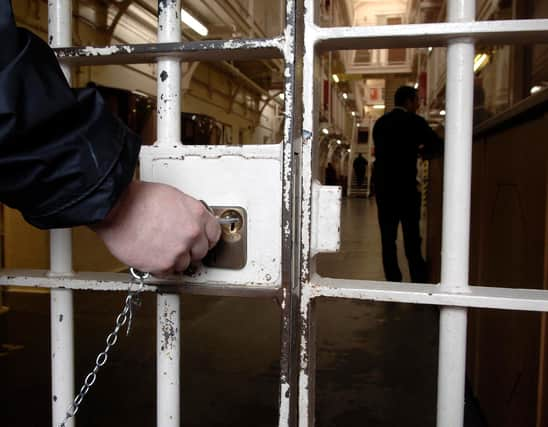Percentage of sex offenders in prison grows as Scottish jails reach breaking point


The overall prison population has also risen sharply in the last few years – despite attempts to reduce short term prison sentences – resulting in a record number of people in jail.
New figures from the Scottish Government show that while the overall average daily prison population has fluctuated since 2010 to 2020, with a steady fall since a peak of 8,133 in 2012, it has expanded rapidly from around 7,500 prisoners in 2017 to almost 8,200 last year.
Advertisement
Hide AdAdvertisement
Hide AdThe statistics come two years on from a warning by the Chief Inspector of Prisons, Wendy Sinclair-Gieben, that the number of inmates was starting to exceed capacity.
Scottish Labour said the data was proof of “14 years of SNP mismanagement which has left our prisons overcrowded and staff under pressure.”
The party’s justice spokesperson Neil Bibby added: “We have to address the causes of crime and the inequalities that are driving the increase in our prison population.
“Scottish Labour would reform our prison system and sentencing to ensure custody is fit for purpose for serious crimes and isn’t acting as a substitute for under-funded mental health or drug and alcohol services.
“Public confidence in alternatives to remand and custodial sentences must be improved, and that means adequate funding and credible plans for community justice alternatives. These measures should be better used for pregnant women and mothers who have committed nonviolent offences.”
The figures show that those serving sentences for sexual offences account for a ”growing proportion” of the average daily prison population – rising from eight per cent of the average sentenced population ten years ago to 16 per cent last year.
The average daily population serving sentences for rape and attempted rape also trebled between 2009-10 and 2019-20, from 213 to 640.
And while women were much less likely than men to be serving a sentence for a sexual offence – last year just one per cent of those behind bars were in that category, compared to 17 per cent of the men’s prison population a greater proportion were serving sentences for violent offences – 40 per cent compared to 36 per cent of the men’s population – and crimes of dishonesty, 17 per cent compared to nine per cent.
Advertisement
Hide AdAdvertisement
Hide AdOverall those serving sentences for violent offences have consistently made up around one third of the prison population, with attempted murder and serious assault the most common violent offences, rising 10 per cent from 975 to 1,072 in the last year.
Meanwhile, the population serving sentences for drugs offences decreased by 36 per cent over the decade from 993 to 637.
Scottish Liberal Democrat justice spokesman, Liam McArthur said: “The steep rise in violent and sexual crime is extremely concerning. Thousands of families will have been left reeling from unthinkable attacks.
“Police officers and staff work tirelessly to keep our communities safe but it’s clear that a lack of resources, the loss of valuable civilian expertise and the reliance on outdated IT systems is hampering their work."
The figures also show that while the average daily prison population has risen, the number of individuals spending time in custody each year fell by around 15 per cent over the same time frame, and those serving a main sentence of up to a year decreased by around 27 per cent. However, the average prison population has risen across all other short and long term sentence groups.
Some sentence groups have seen sharp recent growth, the figures show: the average population serving sentences between four and 10 years increased from 1,147 in 2017-18 to 1,318 in 2019-20.
Others have seen more consistent growth, with the average population serving life sentences rising from 839 in 2009-10 to 948 in 2019-20, and those with an Order of Lifelong Restriction rising from an average of 57 to 185 over the same time period.
The data, from Scotland’s Chief Statistician also shows that the numbers leaving prison on conditional release has decreased by around 60 per cent between 2017-18 and 2019-20. Departures on license, parole, under Supervised Release Order or Home Detention Curfew, also fell from between 20 to 24 per cent from 2010 to 2018 to just 11 per cent in 2019-20.
Advertisement
Hide AdAdvertisement
Hide AdScottish Conservative’s justice spokesperson Liam Kerr said the SNP had “effectively scrapped short prison sentences” and “thousands of criminals are now avoiding jail sentences”.
He added: “This is one of the worst examples of the SNP’s soft-touch justice attitude. It is a complete betrayal of victims who are all too often an afterthought for SNP ministers and has allowed many dangerous criminals to avoid meaningful punishment.
“The Scottish Conservatives are committed to introducing a Victims Law as our first piece of legislation in the next Parliament. This would end the SNP’s effective ban on short prison sentences and put victims interests first to ensure that the justice system is finally on their side.
“Our Victims Law will also introduce whole life custody for the worst criminals to guarantee that life means life behind bars.”
Overall, women were more likely than men to be serving a short custodial sentence with only 12 per cent of the women’s average daily sentenced population serving determinate sentences of more than four years last year compared to 24 per cent of men.
The SNP has been asked for comment.